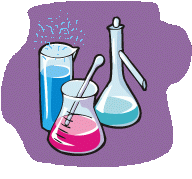


Description of experiment
Below follows a plain text transcript of the selected experiment.
![]()
Needed compounds:
-----------------
sulphuric acid : H2SO4
nickel nitrate : Ni(NO3)2 . 6H2O
sodium bromide : NaBr
Class:
------
elem=Ni,Br
redox
coordination
Summary:
--------
Nickel (II) forms a coordination complex with bromide, but only in very
concentrated bromide solutions.
Such a concentrated bromide solution is oxidized by concentrated sulfuric
acid extremely rapidly.
Description:
------------
Add solid NaBr to a solution of nickel nitrate. Add so much of the NaBr, such
that no more solid dissolves and the liquid becomes highly concentrated with
bromide: When the first quantities of sodium bromide are added and dissolved,
no visible changes occur (besides the dissolving of the solid), but from a
certain point, dissolving more bromide results in intensifying of the color
of the liquid and shifting of the color from green to brown. Finally, when
the liquid is saturated with respect to NaBr, the color is moss green / brown.
When the liquid is diluted with its own volume of water, then it becomes pale
green again, the ordinary color of aqueous nickel (II) ions.
Add concentrated sulfuric acid (appr. 98% H2SO4) to the saturated bromide
solution (which is moss green/brown). The volume of added sulfuric acid
is appr. 25% of the volume of the bromide solution: Violent reaction,
a lot of bromine is produced. The liquid becomes hot and dark brown, almost
black. Apparently there is bromine in the liquid in a super-heated state,
which at certain moments suddenly boils, resulting in sudden large expansions,
producing large amounts of gaseous bromine. This physical effect can also be
observed when boiling water. The temperature can rise, fairly much above the
boiling point, without evolution of water vapour, and suddenly a lot of
water boils at once. This effect probably causes the behavior, observed in
this experiment, but now bromine taking the place of water.
![]()